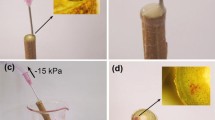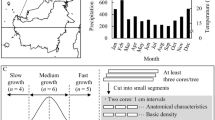Abstract
Key message
Xylem anatomical traits can be categorized into two groups: plastic properties which show a high inter-annual variability, and static characteristics which vary in a more conservative range.
Abstract
Water conduction in broad-leaved trees depends mainly on the size, number, and arrangement of vessels, which vary from year to year in response to varying exogenous factors, thus contributing to a safe and/or efficient water transport. However, the nature of such compensation is not clear; in particular, it is not obvious which traits act independently and which ones coincidentally. To better understand these inter-relations, tree-ring width (TRW), vessel-related anatomical traits, and the theoretical hydraulic conductivity were measured or modeled in the last 50 growth rings of mature Oriental beech trees growing at different altitudes in northern Iran. The study trees followed similar strategies compensating the effects of external factors by modifying their vessel-anatomical features. TRW and the number of vessels per unit of area were highly but negatively correlated and both were affected by exogenous factors. However, a decrease in vessel frequency (VF) is not a mirror effect of wider tree rings, but trees actively control the number of vessels produced. Principal component analysis revealed that the features VF, TRW and relative total conductivity were more plastic, whereas average vessel-lumen area, tree-ring porosity, and relative specific conductivity behaved more static. Moreover, we suggest that in theoretical approaches, total hydraulic conductivity rather than the specific hydraulic conductivity is a better indicator of a tree’s hydraulic behavior in a given growing season.




Similar content being viewed by others
References
Aguilar-Rodríguez S, Terrazas T, López-Mata L (2006) Anatomical wood variation of Buddleja cordata (Buddlejaceae) along its natural range in Mexico. Trees 20:253–261
Anfodillo T, Deslauriers A, Menardi R, Tedoldi L, Petit G, Rossi S (2012) Widening of xylem conduits in a conifer tree depends on the longer time of cell expansion downwards along the stem. J Exp Bot 63:837–845
Arbellay E, Fonti P, Stoffel M (2012) Duration and extension of anatomical changes in wood structure after cambial injury. J Exp Bot 63:3271–3277
Bayramzadeh V, Funada R, Kubo T (2008) Relationships between vessel element anatomy and physiological as well as morphological traits of leaves in Fagus crenata seedlings originating from different provenances. Trees 22:217–224
Bayramzadeh V, Attarod P, Ahmadi MT, Rezaee Amruabadi SH, Kubo T (2011) Does the climate of the origin control anatomical characteristics of the vessel elements as well as different foliar traits in Fagus crenata? J For Sci 57:377–383
Campelo F, Nabais C, Gutiérrez E, Freitas H, García-González I (2010) Vessel features of Quercus ilex L. growing under Mediterranean climate have a better climatic signal than tree-ring width. Trees 24:463–470
Carlquist S (1977) Ecological factors in wood evolution: a floristic approach. Am J Bot 64:887–896
Carlquist S (2001) Comparative wood anatomy: systematic, ecological, and evolutionary aspects of dicotyledon wood. Springer, Berlin
Carlquist SW, Hoekman DA (1985) Ecological wood anatomy of the woody southern Californian flora. IAWA Bull 6:319–347
Crous CJ, Jacobs SM, Esler KJ (2012) Wood anatomical traits as a measure of plant responses to water availability: invasive Acacia mearnsii De Wild. compared with native tree species in fynbos riparian ecotones, South Africa. Trees 26:1527–1536
Cruiziat P, Cochard H, Améglio T (2002) The hydraulic architecture of trees: main concepts and results. Ann For Sci 59:723–752
Dodd RS (1984) Radial and tangential diameter variation of wood cells within trees of Acer pseudoplatanus. IAWA Bull 5:253–257
Eckstein D, Frisse E (1979) Environmental influences on the vessel size of beech and oak. IAWA Bull 2–3:36–37
Fan ZX, Zhang SB, Hao GY, Slik JWF, Cao KF (2012) Hydraulic conductivity traits predict growth rates and adult stature of 40 Asian tropical tree species better than wood density. J Ecol 100:732–741
Fisher JB, Goldstein G, Jones TJ, Cordell S (2007) Wood vessel diameter is related to elevation and genotype in the Hawaiian tree Metrosideros polymorpha (Myrtaceae). Am J Bot 94:709–715
Fonti P, Jansen S (2012) Xylem plasticity in response to climate. New Phytol 195:734–736
García-Suárez AM, Butler CJ, Baillie MGL (2009) Climate signal in tree-ring chronologies in a temperate climate: a multi-species approach. Dendrochronologia 27:183–198
Gärtner H, Nievergelt D (2010) The core-microtome: a new tool for surface preparation on cores and time series analysis of varying cell parameters. Dendrochronologia 28:85–92
Gasson PE (1985) Automatic measurement of vessel lumen area and diameter with particular reference to pedunculate oak and common beech. IAWA Bull 6:219–237
Hacke UG, Sperry JS, Wheeler JK, Castro L (2006) Scaling of angiosperm xylem structure with safety and efficiency. Tree Physiol 26:689–701
Hao GY, Wheeler JK, Holbrook NM, Goldstein G (2013) Investigating xylem embolism formation, refilling and water storage in tree trunks using frequency domain reflectometry. J Exp Bot 64(8):2321–2332
Hass P, Wittel FK, McDonald SA, Marone F, Stampanoni M, Herrmann HJ, Niemz P (2010) Pore space analysis of beech wood: the vessel network. Holzforschung 64:639–644
Hubbard RM, Ryan MG, Stiller V, Sperry JS (2001) Stomatal conductance and photosynthesis vary linearly with plant hydraulic conductance in ponderosa pine. Plant Cell Environ 24:113–121
Ishida A, Nakano T, Yazaki K, Matsuki S, Koike N, Lauenstein DL, Shimizu M, Yamashita N (2008) Coordination between leaf and stem traits related to leaf carbon gain and hydraulics across 32 drought-tolerant angiosperms. Oecologia 156:193–202
Köse N, Güner HT (2012) The effect of temperature and precipitation on the intra-annual radial growth of Fagus orientalis Lipsky in Artvin, Turkey. Turk J Agric For 36:501–509
Kramer PJ, Boyer JS (1995) Water relations of plants and soils. Academic Press, London
Leal S, Pereira H, Grabner M, Wimmer R (2003) Clonal and site variation of vessels in 7-year-old Eucalyptus globulus. IAWA J 24:185–195
Martre P, Durand JL, Cochard H (2000) Changes in axial hydraulic conductivity along elongating leaf blades in relation to xylem maturation in tall fescue. New Phytol 146:235–247
Martre P, Cochard H, Durand JL (2001) Hydraulic architecture and water flow in growing grass tillers (Festuca arundinacea Schreb.). Plant Cell Environ 24:65–76
Nobel PS (2009) Physicochemical and environmental plant physiology, 4th edn. Academic Press, London
Oladi R, Pourtahmasi K, Eckstein D, Bräuning A (2011) Seasonal dynamics of wood formation in Oriental beech (Fagus orientalis Lipsky) along an altitudinal gradient in the Hyrcanian forest, Iran. Trees 25:425–433
Patiño S, Tyree MT, Herre EA (1995) Comparison of hydraulic architecture of woody plants of differing phylogeny and growth form with special reference to freestanding and hemi-epiphytic Ficus species from Panama. New Phytol 129:125–134
Piovesan G, Adams JM (2001) Masting behaviour in beech: linking reproduction and climatic variation. Can J Bot 79:1039–1047
Plavcová L, Hacke UG (2012) Phenotypic and developmental plasticity of xylem in hybrid poplar saplings subjected to experimental drought, nitrogen fertilization, and shading. J Exp Bot 63:6481–6491
Poorter L, McDonald I, Alarcón A, Fichtler E, Licona JC, Peña-Claros M, Sterck F, Villegas Z, Sass-Klaassen U (2010) The importance of wood traits and hydraulic conductance for the performance and life history strategies of 42 rainforest tree species. New Phytol 185:481–492
Pourtahmasi K, Lotfiomran N, Bräuning A, Parsapajouh D (2011) Tree-ring width and vessel characteristics of oriental beech (Fagus orientalis) along an altitudinal gradient in the Caspian forests, Northern Iran. IAWA J 32:461–473
Preston KA, Cornwell WK, DeNoyer JL (2006) Wood density and vessel traits as distinct correlates of ecological strategy in 51 California coast range angiosperms. New Phytol 170:807–818
Reyes-Santamaría I, Terrazas T, Barrientos-Priego AF, Trejo C (2002) Xylem conductivity and vulnerability in cultivars and races of avocado. Sci Hortic 92:97–105
Sano Y, Morris H, Shimada H, Ronse De Craene LP, Jansen S (2011) Anatomical features associated with water transport in imperforate tracheary elements of vessel-bearing angiosperms. Ann Bot 107:953–964
Santiago LS, Goldstein G, Meinzer FC, Fisher JB, Machado K, Woodruff D, Jones T (2004) Leaf photosynthetic traits with hydraulic conductivity and wood density in Panamanian forest canopy trees. Oecologia 140:543–550
Sass U, Eckstein D (1995) The variability of vessel size of beech (Fagus sylvatica L.) and its ecophysiological interpretation. Trees 9:247–252
Schmitz N, Verheyden A, Beeckman H, Kairo JG, Koedam N (2006) Influence of a salinity gradient on the vessel characters of the mangrove species Rhizophora mucronata. Ann Bot 98:1321–1330
Schuldt B, Leuschner C, Brock N, Horna V (2013) Changes in wood density, wood anatomy and hydraulic properties of the xylem along the root-to-shoot flow path in tropical rainforest trees. Tree Physiol 33:161–174
Schume H, Grabner M, Eckmüllner O (2004) The influence of an altered groundwater regime on vessel properties of hybrid poplar. Trees 18:184–194
Sperry JS, Hacke UG, Pittermann J (2006) Size and function in conifer tracheids and angiosperm vessels. Am J Bot 93:1490–1500
Sperry JS, Meinzer FC, McCulloh KA (2008) Safety and efficiency conflicts in hydraulic architecture: scaling from tissues to trees. Plant Cell Environ 31:632–645
Steppe K, Lemeur R (2007) Effects of ring-porous and diffuse-porous stem wood anatomy on the hydraulic parameters used in a water flow and storage model. Tree Physiol 27:43–52
Thomas P (2000) Trees: their natural history. Cambridge University Press, Cambridge
Tixier A, Cochard H, Badel E, Dusotoit-Coucaud A, Jansen S, Herbette S (2013) Arabidopsis thaliana as a model species for xylem hydraulics: does size matter? J Exp Bot 64:2295–2305
Tombesi S, Johnson RS, Day KR, DeJong TM (2010) Relationships between xylem vessel characteristics, calculated axial hydraulic conductance and size-controlling capacity of peach rootstocks. Ann Bot 105:327–331
Tyree MT, Zimmerman MH (2002) Xylem structure and the ascent of sap. Springer, Berlin
Umebayashi T, Utsumi Y, Koga S, Inoue S, Matsumura J, Oda K, Fujikawa S, Arakawa K, Otsuki K (2010) Xylem water-conducting patterns of 34 broadleaved evergreen trees in Southern Japan. Trees 24:571–583
Verheyden A, De Ridder F, Schmitz N, Beeckman H, Koedam N (2005) High-resolution time series of vessel density in Kenyan mangrove trees reveal a link with climate. New Phytol 167:425–435
Wagner KR, Ewers FW, Davis SD (1998) Tradeoffs between hydraulic efficiency and mechanical strength in stems of four co-occurring species of chaparral shrubs. Oecologia 117:53–62
Zubizarreta-Gerendiain A, Gort-Oromi J, Mehtätalo L, Peltola H, Venäläinen A, Pulkkinen P (2012) Effects of cambial age, clone and climatic factors on ring width and ring density in Norway spruce (Picea abies) in SouthEastern Finland. For Ecol Manage 263:9–16
Acknowledgments
Particular acknowledgement is due to the DAAD (German Academic Exchange Service) for the financial support of R. Oladi during the laboratory works in Germany.
Conflict of interest
The authors declare that they have no conflict of interest.
Author information
Authors and Affiliations
Corresponding author
Additional information
Communicated by J. Lin.
Electronic supplementary material
Below is the link to the electronic supplementary material.
Rights and permissions
About this article
Cite this article
Oladi, R., Bräuning, A. & Pourtahmasi, K. “Plastic” and “static” behavior of vessel-anatomical features in Oriental beech (Fagus orientalis Lipsky) in view of xylem hydraulic conductivity. Trees 28, 493–502 (2014). https://doi.org/10.1007/s00468-013-0966-x
Received:
Revised:
Accepted:
Published:
Issue Date:
DOI: https://doi.org/10.1007/s00468-013-0966-x




